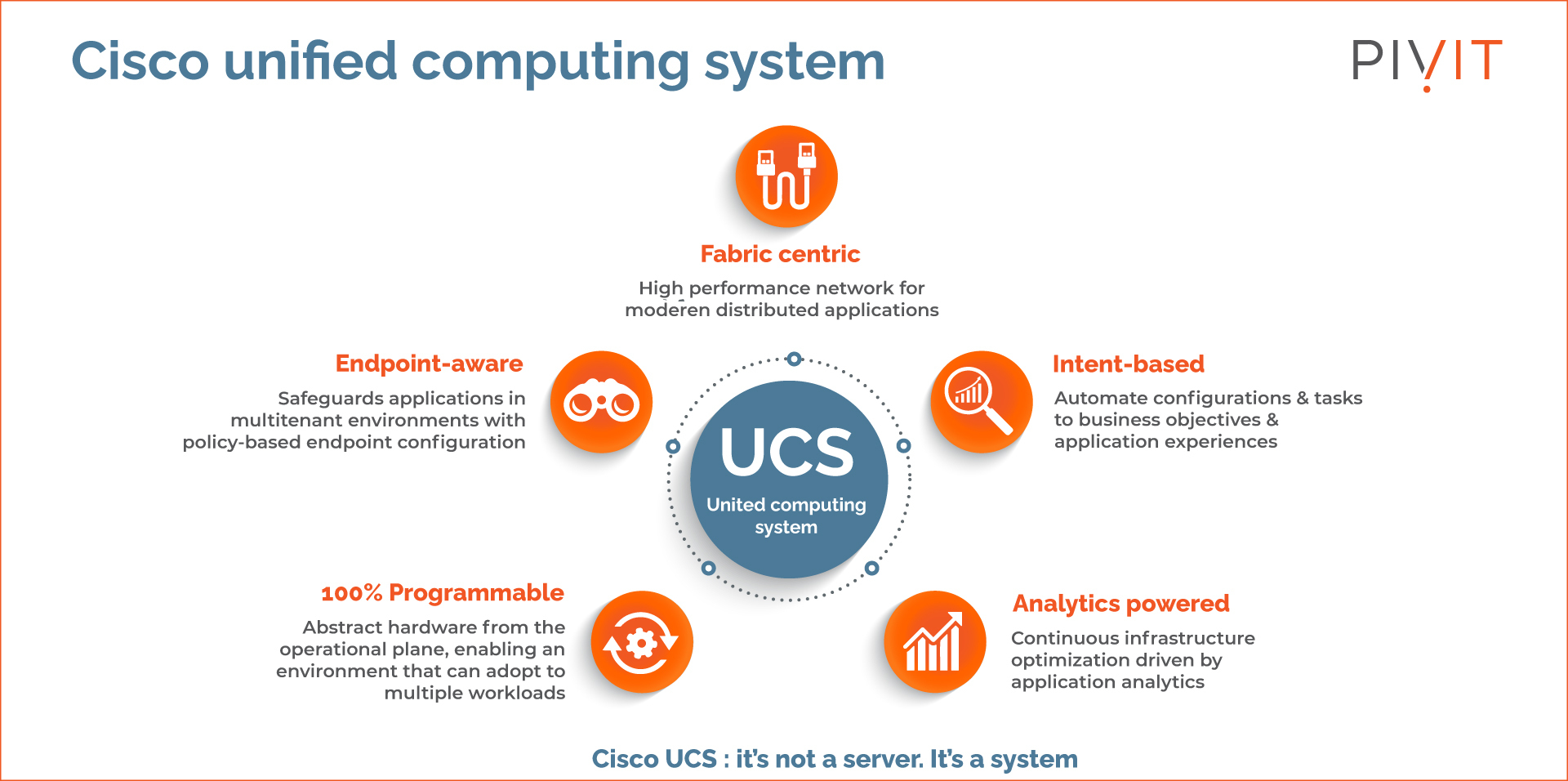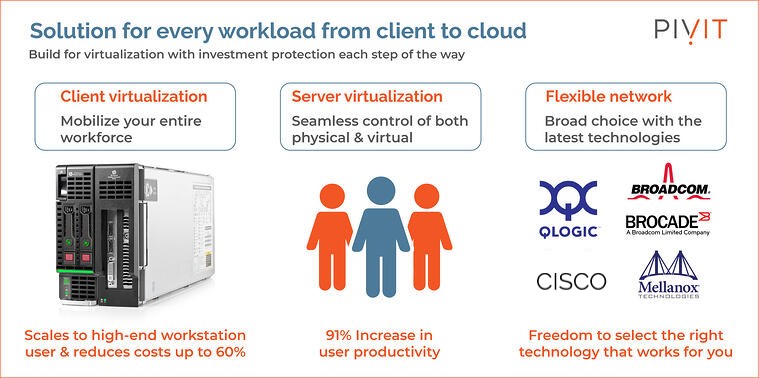Blade Server Comparisons - Cisco UCS and HPE BL Series Models
-2.png)
The rapid digitization of our world results in massive growth in applications - traditional, cloud-native, hybrid apps, and more. Organizations everywhere are fighting to keep up with demands to support more applications in more locations than ever. Companies want flexible consumption models, consistent operations, and optimized security, performance, and availability across their data center environments.
This blog will compare the Cisco UCS Blade Server and the HPE BL Series Blade Server, both market leaders in blade server technology.
Cisco UCS Blade Server Overview
Cisco UCS is designed to work with half-width and full-width, and even full-width double-height blade servers. Cisco UCS B-Series Blade Servers are designed for compatibility, performance, energy efficiency, large memory capacity, manageability, and unified I/O connectivity.
Based on Intel Xeon processors, the proposed Cisco UCS B-Series Blade Servers can adapt to application demands, intelligently scale energy use, and offer robust virtualization while delivering reliability and security features to maximize the availability of mission-critical applications.
Cisco UCS B-Series Blade Servers can help organizations:
- Advance server performance, flexibility, and scale for virtualized and non-virtualized applications.
- Deploy server applications quicker and manage connectivity as required.
- Minimize the number of adapters, cables, and access-layer switches needed for server LAN and SAN connectivity.

Cisco UCS Blade Server Models
The various Cisco UCS blade server models include Cisco UCS B200 M5/M6 Blade and Cisco UCS B480 M5 Blade.
Cisco UCS B200 Series Blade Server
The Cisco UCS B200 Series Blade Server delivers flexibility, performance, and optimization for deployments in the cloud, data centers, and remote sites. This enterprise-class server gives market-leading performance, density, and versatility without negotiating workloads, including virtual web infrastructure, converged infrastructure, Desktop Infrastructure (VDI), and enterprise applications such as SAP HANA and Oracle.
The B200 Series servers can quickly deploy stateless physical and virtual workloads through easy-to-use, programmable Cisco UCS Manager software, and Cisco Intersight.
Cisco UCS B480 M5 Series Blade Servers
The Cisco UCS B480 M5 Blade Server provides excellent performance, enterprise-critical security, and stability for computing and memory-intensive workloads such as in-memory analytics, large-scale databases, and business intelligence.
With the Cisco UCS B480 M5, you can quickly deploy stateless physical and virtual workloads with the programmability of the Cisco UCS Manager. In addition, it also provides exceptional performance, flexibility, and I/O throughput to run your most critical and demanding applications.
With the Cisco UCS B480 M5, you can quickly deploy stateless physical and virtual workloads with the programmability of the Cisco UCS Manager.
Feature Comparison Among Cisco UCS Blade Servers
|
Features |
B200 M6 |
B200 M5 |
B480 M5 |
|
Number of processors |
2 |
2 |
4 |
|
Processor supported |
3rd Gen Intel Xeon Scalable processors |
2nd Gen Intel Xeon Scalable and Intel Xeon Scalable processors |
2nd Gen Intel Xeon Scalable and Intel Xeon Scalable processors |
|
Maximum memory |
12 TB with Intel Optane Pmem |
9 TB with Intel Optane Pmem |
18 TB with Intel Optane Pmem |
|
Form factor |
Half-width blade |
Half-width blade |
Full-width blade |
|
RAID |
0, 1 |
0, 1 |
0, 1 |
|
Mezzanine I/O adapter slots |
2 |
Up to 3 |
Up to 5 |
|
GPUs |
0 |
Up to 2 |
Up to 4 |
|
Max I/O throughput per blade |
80 Gbps (2 x 40 Gbps) |
80 Gbps (2 x 40 Gbps) |
160 Gbps (4 x 40 Gbps) |
|
Maximum servers per chassis |
8 |
8 |
4 |
|
Storage |
|||
|
Internal storage |
Up to four M.2 SATA or two 7mm SAS/SATA/NVMe |
Up to two SAS/SATA/SSD/NVMe |
Up to four SAS/SATA/SSD/NVMe |
|
Maximum internal storage |
15.2 TB |
20.5 TB |
39 TB |
Does the UCS platform fit your needs? Click below to request a quote for your next UCS server.
HPE BL Series Blade Server Overview
HPE BladeSystem is the foundation of HPE Converged Infrastructure and delivers the architecture for any workload from client to cloud. HPE BladeSystem provides cost savings, energy efficiency, and improved IT staff productivity compared to traditional infrastructures. HPE BladeSystem services use technology to accelerate business growth and can significantly reduce infrastructure costs.

HPE BL Series Blade Server Models
The available HPE models include the HPE ProLiant e910, HPE Integrity BL860c i6, HPE Integrity BL870c i6, and HPE Integrity BL890c i6 Server Blade. They come with the remote management feature called HPE iLO five, which helps to manage, monitor, and configure the servers remotely from anywhere.
HPE Proliant is an x86 platform, and HPE Integrity is a RISC platform operating system. Integrity is running on UNIX operating system, which is called HP UX. HP UX is a very light and advanced RISC-based operating system popular in the telecommunication and financial sectors.
Feature Comparison Among HPE BL Blade Servers
|
Features |
HPE ProLiant e910 Server Blade |
HPE Integrity BL870c i6 Server Blade |
HPE Integrity BL890c i6 Server Blade |
HPE Integrity BL860c i6 Server Blade |
|
Memory Slots |
12 DIMM slots |
48 DIMM slots |
96 DIMM slots |
24 DIMM slots |
|
Maximum Memory |
1.5TB |
768 GB |
1.5 TB |
384 GB |
|
Processor Core Available |
24 Core |
8 or 4 |
8 or 4 |
8 or 4 |
|
Memory Type |
HPE DDR4 SmartMemory |
DDR3 LRDIMM or RDIMM |
DDR3 LRDIMM or RDIMM |
DDR3 LRDIMM or RDIMM |
|
Expansion Slots |
Up to quantity of 4 - for details on configuration options, refer to the QuickSpecs |
Six maximum, for detailed descriptions, reference the QuickSpecs |
12 max, for detailed descriptions, reference the QuickSpecs |
Three maximum, for detailed descriptions, reference the QuickSpecs |
|
Processor Family |
Intel Xeon Scalable 8200 series Intel Xeon Scalable 6200 series Intel Xeon Scalable 5200 series Intel Xeon Scalable 4200 series |
Intel Itanium 9700 series |
Intel Itanium 9700 series |
Intel Itanium 9700 series |
|
Remote Management Software |
HPE iLO 5 Advanced, features are standard |
Integrity iLO 3 with Advanced Pack |
Integrity iLO 3 with Advanced Pack |
Integrity iLO 3 with Advanced Pack |
|
Processor Speed |
2.4 GHz |
2.66 GHz |
2.53 GHz |
2.66 GHz |
|
Graphics |
Available options (PCIe I/O) |
Integrated ATI RN50 1280 x 1024 x 16M color |
Integrated ATI RN50 1280 x 1024 x 16M color |
Integrated ATI RN-50 1280 x 1024 x 16M color |
|
Processor Cache Installed |
35.75 MB L3 |
32 MB L3 24 MB L3 20 MB L3 |
32 MB L3 24 MB L3 20 MB L3 |
32 MB L3 24 MB L3 20 MB L3 |
|
Network Controller |
- |
4 HPE 10Gb 526FLB FlexFabric adapter 8-ports per controller, applicable to all models |
8 HPE 10Gb 526FLB FlexFabric adapter 16-ports per controller, applicable to all models |
10Gb NC553i FlexFabric Adapter 4 Ports per controller Applicable to all models |
|
Processor Number |
1 per HPE ProLiant e910 Server Blade |
Up to four Intel Itanium 9700 Series processors |
Up to eight Intel Itanium 9700 Series processors |
Up to two Intel Itanium 9700 Series processors |
Looking To Purchase Your Next Server?
PivIT has a broad selection of server models and providers—with prices that help minimize your expense while maximizing quality. We will help you create CapEx by reducing your OpEx, saving you an average of 65% on your gear. You'll get the servers you need at the price you'll love and with a lead time you can't beat.

